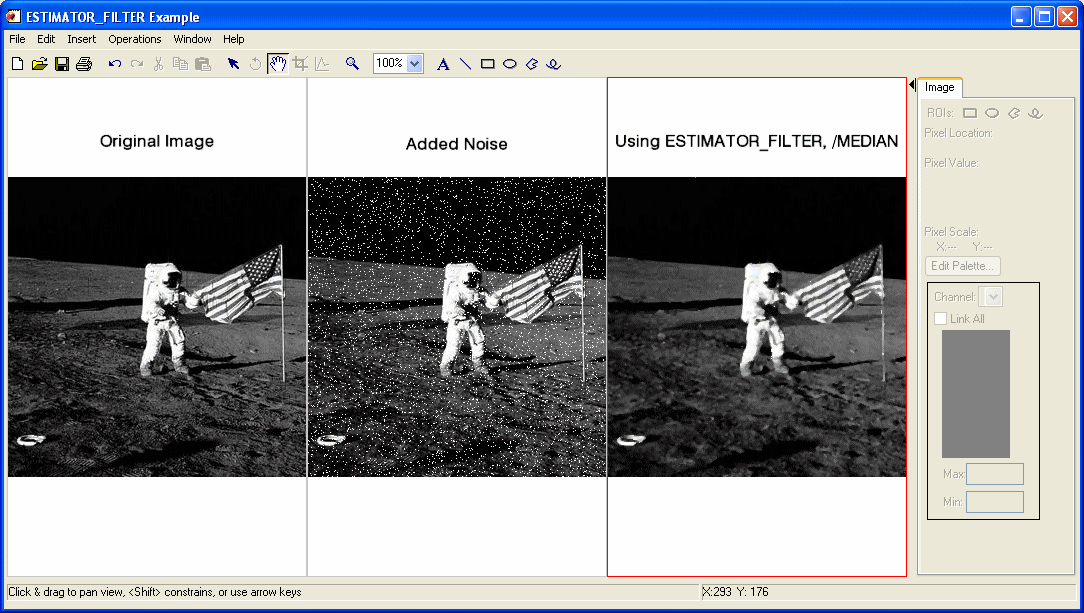The ESTIMATOR_FILTER function applies an order statistic noise-reduction filter to a one-channel image.
For each pixel in the image, the estimator filter analyzes the neighboring pixels. The order statistic estimator is computed for this neighborhood and the pixel is replaced by the result.
This routine is written in the IDL language. Its source code can be found in the file estimator_filter.pro in the lib subdirectory of the IDL distribution.
Syntax
Result = ESTIMATOR_FILTER( ImageData, Width [, Height] [, INVALID=value] [, /MEDIAN] [, /MIDPOINT] [, MISSING=value] [, /NAN] [, TRUNCATE=value] )
Return Value
Returns an array containing the filtered image, which has the same dimensions and type as ImageData.
Arguments
ImageData
A two-dimensional array containing the pixel values of the input image.
Width
The width of the two-dimensional neighborhood. Since the neighborhood is centered on a pixel, this value must be an odd, positive integer.
Height
The height of the two-dimensional neighborhood. Since the neighborhood is centered on a pixel, this value must be an odd, positive integer. If this value is omitted, Height is set to Width, resulting in a square neighborhood.
Keywords
INVALID
Set this keyword to a scalar value of the same type as ImageData that should be used to indicate missing or invalid data within ImageData. Missing data are ignored when computing the mean of an element’s neighborhood. In Result, missing elements are replaced by the mean of all other valid points within that element’s neighborhood.
Tip: The INVALID keyword has the same effect as the NAN keyword, but is useful for byte or integer data which have missing values.
Note: The INVALID keyword uses a simple comparison to ignore values and should not be set to NaN. For floating-point data, you can use the INVALID and NAN keywords simultaneously to filter out both user-defined values and NaN or Infinity values.
MEDIAN
Set this keyword to replace a pixel with the neighborhood median value. Using the median value reduces unipolar and bipolar impulse noise (also known as salt-and-pepper noise) without introducing blur.
For Sx,y, the m x n neighborhood surrounding the pixel ƒ(x,y), the median pixel is given by:

MIDPOINT
Set this keyword to replace a pixel with the neighborhood midpoint value. Using the midpoint estimator reduces Gaussian noise.
For Sx,y, the m x n neighborhood surrounding the pixel ƒ(x,y), the midpoint pixel is given by:

MISSING
Set this keyword to the value that will be substituted for missing data. This keyword is used only if the INVALID or NAN keyword is set.
NAN
Set this keyword to check for occurrences of the IEEE floating-point values NaN or Infinity in the input data. Pixels with the value NaN or Infinity are treated as missing data. Missing data are ignored when computing the mean of an element’s neighborhood. In Result, missing elements are replaced by the mean of all other valid points within that element’s neighborhood.
Note: ESTIMATOR_FILTER should never be called without the NAN keyword if the input array may possibly contain NaN or Infinity values.
TRUNCATE
Set this keyword to a value between 0 and 100 that represents the percentage of total data to be trimmed from the truncated (or alpha-trimmed) mean of each neighborhood.
If d is the keyword value, the filter trims the d/2% largest and d/2% smallest values and calculates the mean of the remaining neighborhood values. If d=0, this filter is equivalent to the arithmetic mean filter; if d=100, this filter is equivalent to the median estimator filter.
For S′x,y, the m x n neighborhood surrounding the pixel ƒ(x,y) with the d/2% largest and smallest values removed from Sx,y, the truncated mean is given by:

Examples
Example 1
In the following example, we add some unipolar impulse (salt) noise to an image and filter it with ESTIMATOR_FILTER, using the MEDIAN keyword.
First, we read the file and add noise to the image:
file = FILEPATH('moon_landing.png', SUBDIR=['examples','data'])
imageOriginal = READ_PNG(file)
noise = RANDOMN(SYSTIME(/SECONDS), 300, 300, /UNIFORM)
noise[WHERE(noise LE .95)] = 0
noise[WHERE(noise GT .95)] = 255
imageNoise = imageOriginal+noise < 255 > 0
imageFiltered = ESTIMATOR_FILTER(imageNoise, 3, /MEDIAN)
Next, we render the result:
dims = [(SIZE(imageOriginal))[1]*3, $
(SIZE(imageOriginal))[2]*1+120]
IIMAGE, imageOriginal, VIEW_GRID=[3,1], $
VIEW_TITLE='Original Image', $
DIMENSIONS=dims, WINDOW_TITLE='ESTIMATOR_FILTER Example', $
/NO_SAVEPROMPT
IIMAGE, imageNoise, /VIEW_NEXT, VIEW_TITLE='Added Noise'
IIMAGE, imageFiltered, /VIEW_NEXT, $
VIEW_TITLE='Using ESTIMATOR_FILTER, /MEDIAN'
ISETPROPERTY, 'text*', FONT_SIZE=36

Example 2
In the following example, we add some uniform noise to an image and filter it with ESTIMATOR_FILTER, using the MIDPOINT keyword.
file = FILEPATH('moon_landing.png', SUBDIR=['examples','data'])
imageOriginal = READ_PNG(file)
noise = randomn(SYSTIME(/SECONDS), 512, 512, /UNIFORM)*150
noise = FIX(noise-75)
imageNoise = imageOriginal + noise < 255 > 0
imageFiltered = ESTIMATOR_FILTER(imageNoise, 3, $
/MIDPOINT)
dims = [(SIZE(imageOriginal))[1]*3, $
(SIZE(imageOriginal))[2]*1+120]
IIMAGE, imageOriginal, VIEW_GRID=[3,1], $
VIEW_TITLE='Original Image', $
DIMENSIONS=dims, WINDOW_TITLE='ESTIMATOR_FILTER Example', $
/NO_SAVEPROMPT
IIMAGE, imageNoise, /VIEW_NEXT, VIEW_TITLE='Added Noise'
IIMAGE, imageFiltered, /VIEW_NEXT, $
VIEW_TITLE='Using ESTIMATOR_FILTER, /MIDPOINT'
ISETPROPERTY, 'text*', FONT_SIZE=36
Example 3
In the following example, we add a mixture of uniform noise and unipolar impulse noise to an image and filter it with ESTIMATOR_FILTER, using the TRUNCATE keyword.
First, we read the file and add noise to the image:
file = FILEPATH('moon_landing.png', SUBDIR=['examples','data'])
imageOriginal = READ_PNG(file)
noise = randomn(SYSTIME(/seconds), 512, 512, /UNIFORM)
noise[WHERE(noise GT .98)] = 255
noise[WHERE(noise LE .98)] *= 75
imageNoise = imageOriginal + noise < 255 > 0
imageFiltered = ESTIMATOR_FILTER(imageNoise, 3, $
TRUNCATE=50)
Next, we render the result:
dims = [(SIZE(imageOriginal))[1]*3, $
(SIZE(imageOriginal))[2]*1+120]
IIMAGE, imageOriginal, VIEW_GRID=[3,1], $
VIEW_TITLE='Original Image', $
DIMENSIONS=dims, WINDOW_TITLE='ESTIMATOR_FILTER Example', $
/NO_SAVEPROMPT
IIMAGE, imageNoise, /VIEW_NEXT, VIEW_TITLE='Added Noise'
IIMAGE, imageFiltered, /VIEW_NEXT, $
VIEW_TITLE='Using ESTIMATOR_FILTER, /TRUNCATE'
ISETPROPERTY, 'text*', FONT_SIZE=36
Version History
See Also
“Overview of Image Processing” (Image Processing in IDL) in the help/pdf directory of your IDL installation,
MEAN_FILTER, BANDPASS_FILTER, BANDREJECT_FILTER, WIENER_FILTER, LEAST_SQUARES_FILTER